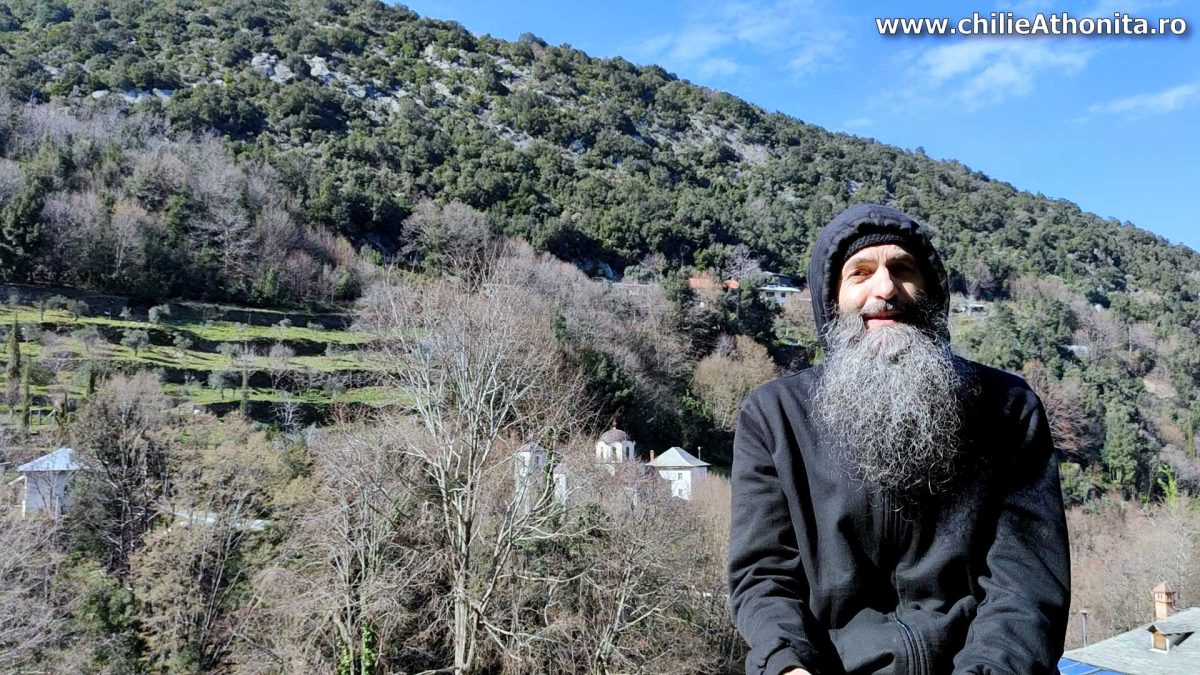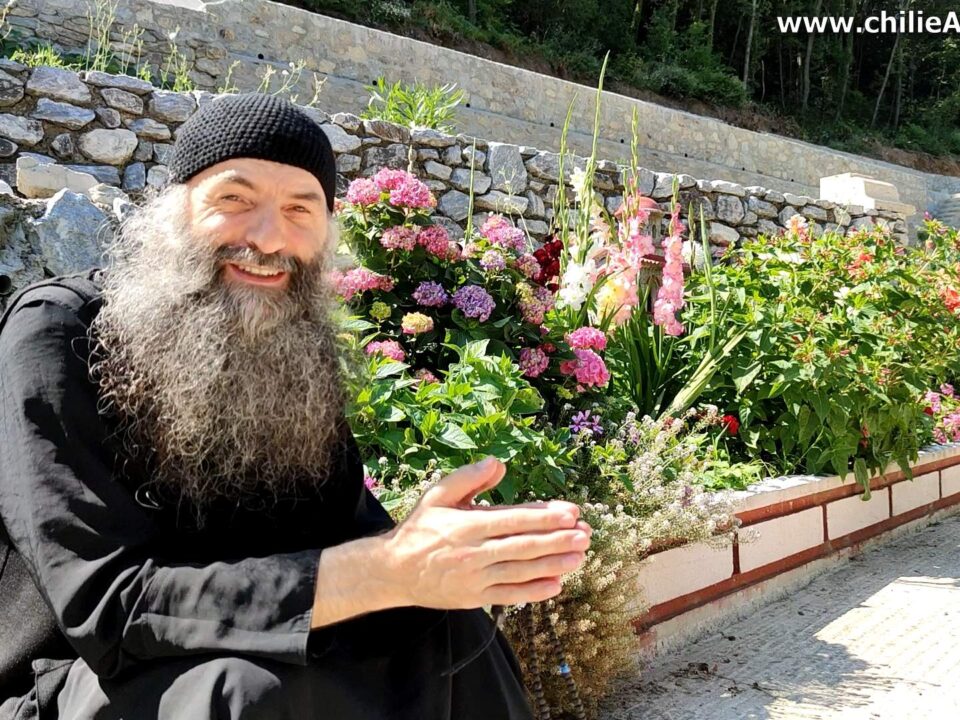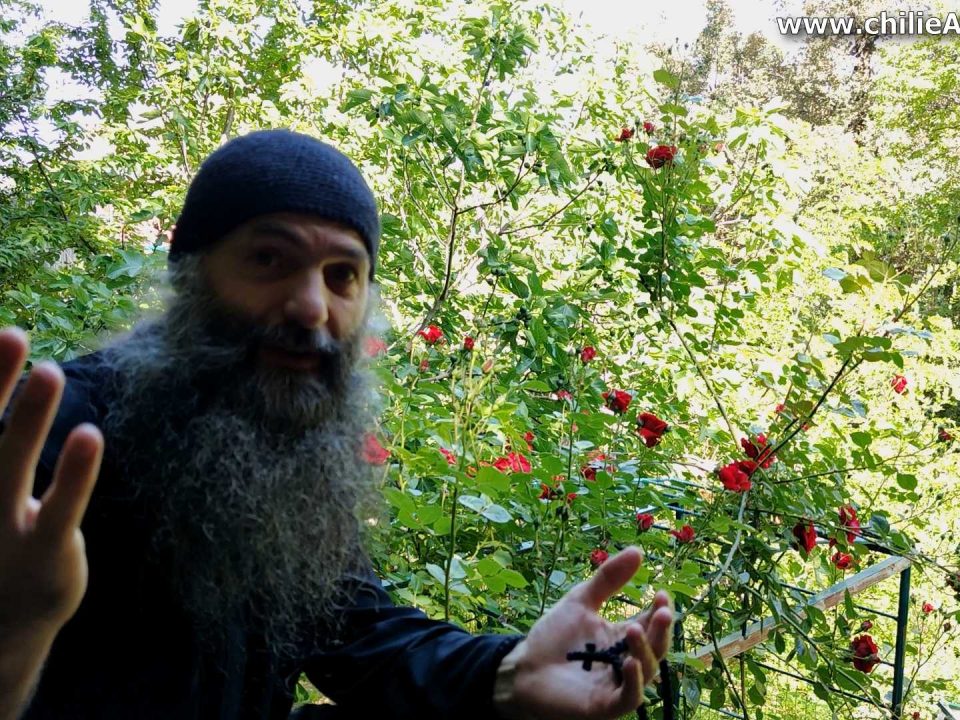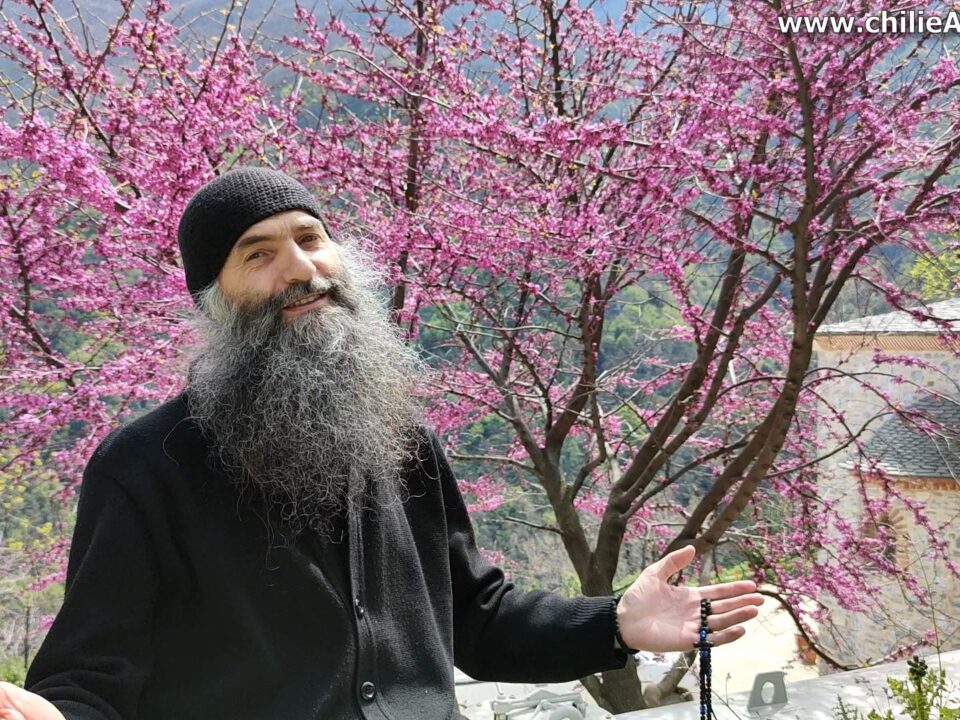
Myths and Truths about the Holy Mountain – Father Theologos
15 March 2022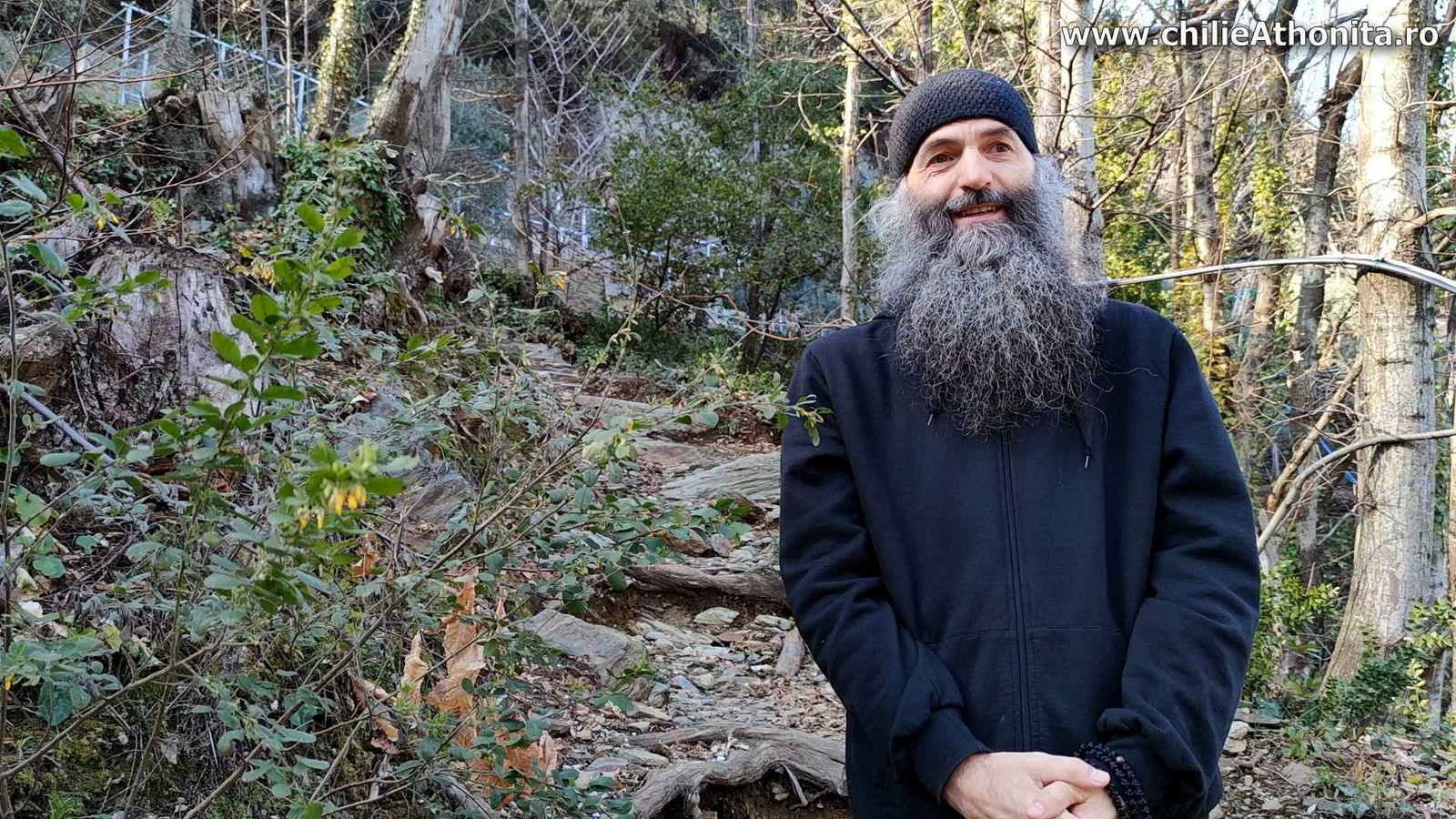
Poverty, Peace, and War – Father Pimen Vlad
24 March 2022Watch father Pimen give a short description of the treasures of St. Paul’s Monastery as well as of other events from that period of his life.
Enjoy!
Look dear ones we are seeing each other again!
I’ll explain later what you are seeing behind me, and now let’s continue where we left off, from the monastery of St. Paul. And I saw that some have asked if it is a virtue to be unwashed when I spoke of father George from St. Paul’s, who had gotten a blessing from his spiritual father and for some 30 years did not wash himself.
So these are very rare cases! In general, let’s put it this way, in the cenobitic life, it is very rare, almost not at all. He was a unique case. Do you know what happens? This happens only in those who have reached a certain measure of holiness, reached dispassion and whose body no longer smells. Only these can do this, very rare cases, as I said, who have already reached a measure of holiness. Because this was mostly practiced in the wilderness in Egypt, in those parts – they had no water there – and then of course they lived like that.
But it’s not recommended in cenobitic monasteries, because at some point you smell. And you’re bothering the people around you if you don’t wash yourself! That is why we, while living the cenobitic life, must seek to rest those around us, that is, to not disturb others by our behavior, by not washing. Because it’s not easy to sit next to a person who smells in church for everyone around them, or to live with him all the time, in the same place, in the same congregation – that’s why it’s not recommended. That’s why I said, these are very rare cases. Yes…
What else did I want to tell you from St. Paul’s…
The name of the monastery is not given from the Holy Apostle Paul. The St. Paul it is named after, is also called of Xeropotamou. Because he lived in a place in Athos, for a time, which was a dry creek. Xeropotamou means dry creek. That’s how he got his name, St. Paul from the dry creek. Because he founded two monasteries – St. Paul’s here and Xeropotamou Monastery which is near Daphne.
St. Paul was the son of an emperor, and he retired to the monastery. But he was beardless, his beard did not grow, and the abbot told him, “I’ll make you a monk when the comb will get stuck in your beard!” And you know what he did? Knowing that his beard did not grow, he took the comb and stuck it in his chin, in the flesh, and when the abbot saw his zeal, he made him a monk. And he reached great holiness. Yes! So now you have an idea of which St. Paul we talk of.
So what else can be found at St. Paul’s?
Very valuable things – the gifts of the Magi! You know that when the Savior came to Jerusalem, the Magi, those who had traveled from Persia, from their own countries, it is said that for almost two years they followed the star and came and brought the Savior gold, myrrh and frankincense. Well, these gifts that were brought are at St. Paul’s. And let me tell you how they got there, I won’t go into their history, how they got from Jerusalem onwards, because it is long, but they eventually reached the hands of Empress Maro.
Who was this empress? She was the daughter of the King of Serbia and due to the politics of the time, she was somehow forced by the Sultan of the time to marry him. And he agreed for her to remain in the Orthodox faith. So he didn’t take away her faith, he left her to her life, but she had to be his wife. Those were the politics. And what would she do? Always, whenever the Turks conquered something, she tried to protect the holy objects – icons, gifts, holy relics.
Well, that’s how the gifts of the Magi ended up in her hands too. And because at that time, many Serbs lived at the monastery of St. Paul, (besides Greeks there were also lots of Serbs), she wanted to give the gifts of the Magi to the monastery of St. Paul. But what did she do? She said, “I want to gift them myself!” Although she knew that women are not allowed in Athos. And from the monastery, from the shore, from down there, from the harbor, it’s more than half a kilometer on the path.
Well, she set off with her retinue towards the monastery with the gifts and halfway along the path, the Mother of God came out in front of her and said: “Woman, what are you doing here? Why do you come to scandalize my sons? Don’t you know women aren’t allowed here? Leave your gifts and go back so that nothing bad happens to you.” And then, she venerated the Mother of God, asked for forgiveness, gave the gifts to the fathers and went back. This is how the gifts of the Magi arrived at the monastery of St. Paul.
Another object they have, apart from abundant holy relics, even large pieces of of the Three Holy Hierarchs, of St. Nectarios, the head of St. Agatha… They have the relics of many saints at St. Paul’s. Eh, they also have another object of significance, the icon of the Mother of God called the Mirror. Where is this icon from? You know that during the time of the iconoclasts, when Emperor Theophilus was fighting against icons; He would take them, burn them, would set them on fire. His wife Theodora was very faithful and did not share the same heresy with him, as they say. She had an icon in her room, and so that he wouldn’t know that it was an icon and she would pray to it, she put a mirror on the back. She kept this icon hanging on the wall as a mirror.
When the emperor came to her he saw a mirror, something normal. After he left and she was alone, she turned the icon over and on the other side was the Mother of God. And she prayed to the Mother of God to tame her husband and to stop the persecution. Yes. And God, in time, listened to her. If you read the history, you will find, how she herself after her husband’s death held a synod there and restored the veneration of icons. Well, this icon is found at the monastery of St. Paul. As I told you, it is an icon that is quite valuable, and miracle-working. That is besides the Myrrhovlytissa icon, of which I have already spoken, which is also at St. Paul’s and which for many years streamed myrrh, until more recently, when the myrrh ceased; that is why it is called Mother of God Myrrhovlytissa. I spoke to you about it at the beginning, how the abbot was praying before it and so on.
What can I tell you from St. Paul’s? I want to end my stories from St. Paul’s with this recording. Another little story, apart from the fact that many miracles happened there, there was a very simple father called father Mina. This was years ago. He was a baker’s helper. So, the father who made the bread, who made the prosphora, who was in charge of the bakery, had father Mina as his helper. But father Mina was a very simple and obedient man, he never asked anything, what he was told, he would do. “Hand the flour!” He would hand over the flour. “Bring water,” “knead this…” “place that here,” he would do. And he prayed continuously.
Well, at one point, the baker got sick and the abbot called him, because he had already had a year of helping at the bakery, “Father Mina, today you will be making bread for the fathers because the father has fallen ill!” Father Mina said, “May it be blessed.” And he went into the bakery. But father Mina didn’t know anything. Since he had just done his obedience, never inquiring into anything and praying, he was confronted with something… And how was the bread made there? At that time, bread was made every day, they were a kind of bread rolls like prosphora – they were a monk’s portion. Eh, and they made bread in the morning to be enough for the evening meal and for the next day in the morning. And after that, the next day, the same, when there were two meals. If there was just one meal, then enough was made for the evening.
And father Mina had to make bread that day for the evening meal. But he went into the bakery, looked around, and didn’t know what to put his hands on or what to start with. So he began to cry and pray. There was an icon of the Mother of God there. “Mother of God, help me! You know I didn’t learn, I’m not skilled, I don’t know what to do! What do I do now? Because the father abbot has told me to make bread, and by mealtime the bread must be ready…” As he was crying and praying, he sees the door to the bakery open, and a woman enters, modestly dressed, sort of like a nun, let’s say. And when he sees her, in his simplicity, does not wonder what the woman was doing there. He said:
“Do you know how to make bread by any chance?”
She said, “I do.”
“Come and help me, because I do not know!”
“Of course, I will help you. Pass me the flour.”
And he began to do exactly as he would with the baker. He would pass things to her and this woman started quickly, kneaded, made, baked – finished the bread much faster than normal with the baker. Beautiful, warm bread. The father was joyful. The woman walked out the door and left.
He didn’t even realize to thank her. He said, “Oh dear, I forgot to thank her! ” The father was happy to have warm bread. At mealtime, he placed the warm bread on the table. And the fathers began to eat bread… And they ate and couldn’t get enough. They said, “Father, bring us more bread!”
He would always make a little more. They left the other food and everyone ate bread. The abbot said, “Something is not right here, I asked this father who is unskilled, so to speak, in making bread, and surely he added milk, sugar… It is not possible to have such sweet bread and so good like we have never eaten!” After the meal was over, so as not to scold him in front of everyone, when father Mina went outside, the abbot called him:
“Come here, Father Mina!”
“Yes, father!” (He was afraid now that he would be scolded if the bread did not turn out or if it wasn’t good.)
“What did you put in that bread?”
Father Mina started to cry and said:
“But I didn’t do it!”
“Then who did it?!”
“Well the woman did.”
“Which woman?”
And that’s when father Mina recovered and thought to himself, wait a minute, what woman in Athos?
“Tell me, what happened?”
“Well, I was crying because I didn’t know how to make it, and a woman came in, she helped me, she kneaded, she made the bread.” And when the abbot heard, he began to weep, he gathered the whole congregation together, asked him to tell the story again and said, “Fathers, that’s it, don’t touch this bread, we’ll cut it into pieces, dry it, and consider it holy! To help the sick and so on.” And in this way they ate a little, knowing that they had eaten bread from the hands of the Mother of God. That is to say, the Mother of God intervened, seeing the simplicity of the baker. She came, gifted it to them, kneaded and made bread for the fathers. So do you see how much love the Mother of God has? And how much care she takes?
Likewise, for a time before, most monasteries in Athos were more self-sufficient. I mean, it wasn’t entirely cenobitic. The fathers had something, aside, let’s say. There was a period like that in Athos. And it was the same at St. Paul’s for a time. And the abbot wanted very much to convert it to the cenobitic life. But he was praying to the Mother of God, “Is what I’m doing right?” He decided to do it, he made the big church in the center, because before there had been a smaller one, he consecrated it and then he made the monastery cenobitic. But he was thinking: “Is what I’m doing right?” Some fathers said, “Father, it’s not so good. If it’s been a certain way for so many years, etc…” It was ambiguous.
So the abbot prayed to the Mother of God to give him a sign. Well, a father in the monastery was sick at the cell and, poor thing, he really wanted to participate, but couldn’t because he was bedridden. Well, the moment the consecration began, he was caught up by the spirit, and he saw himself in the church. Meaning he could see everything that was happening in the church. And he saw a woman dressed in a proper way, how she was arranging everything, in the pew – how the singers should sing; in the church, in the altar she would go, she would show them how to put things on the holy table, she would take care of everything like at a consecration, you know, when the holy table is dressed, everything is arranged… She took care of everything.
And he marveled, saying, “Eh, she must be an empress who takes care of everything!” After that, he saw her go into the kitchen. She was helping the cooks with what to put in the food to make it good. They were preparing fish, as it was then, and then she started putting fish on the table. Well, he saw himself helping to put the fish on the table with her.
After that, when it was over, when all the fathers ate, it was the turn of the fathers serving at the refectory, for the cooks to eat. So he asked her too, “Come, join us for lunch!” She said, “No, I don’t eat this food, but I came here to rejoice with you and you should know that I am very happy for what has been done now and that it has been changed to the cenobitic life, because it will be much better spiritually for the fathers.” After that she disappeared. Then this brother, after the consecration, when the abbot came to see him, because he was in bed, – subsequently he even recovered and became healthy – he told the father abbot everything. Then the father abbot rejoiced at the Mother of God’s assurance, that the return to cenobitic life was well received.
What does the cenobitic life mean?
It means having nothing of your own. It’s all communal, no matter what the monastery has! Because it needs to have a few things – cars, tractors, whatever else is needed, especially if the community is large. 50, 100 monks, or as the case may be. And many people come, so they must have something there. But they all belong to the monastery. The monks, under obedience, if they have to go somewhere, they still leave with their bag on their backs, as they say… If he’s to stay there, he’s buried in the cemetery, there’s nothing of his personally. It all belongs to the monastery.
So, somehow, we monks are passing through the monastery, we partake of the customs, the services, the understanding between the brothers, partake of what the monastery has and we leave, as they say, to God. As we came, with our bag and nothing else we go beyond. Yes! I will end it here because I am getting into lots of things again, and it does not end…
Every year after Pascha, I think the day after, I don’t even remember now, there is a procession at St. Paul’s with all the holy relics, with the miracle-working icon called the Mirror, with everything, somewhere uphill from the monastery, at the cave where St. Paul struggled. And there they have a procession, bless the water and return afterwards with everything, back to the monastery, singing a sort of Paraklis to Mother of God. It’s actually done for the feast of the Life-giving Spring, when the water is blessed and everything. Yes! In Bright Week!
To conclude with St. Paul’s and with what I have to say now, the time came when I completed 2 years of obedience there. As I said, an obedience which I did with a lot of love and joy in the cenobitic life there. The time had come, like I had told the fathers from the monastery, that I would like to stay for 2 years, and then come back to build a cell at Lacu Skete. The time had come, although my elder to whom I was obedient for 2 years, Father Anthony, asked me to stay, because we got along very well and he said, “Stay and help me!” I said, “Father, the time has come, this is it…”
And at that time I wanted very much the cell of the Entry of the Most Holy Theotokos into the Temple. Since then I wanted it very much. But the others here at the Skete were all in ruin, there were only about 3 cells at that time, at the beginning, that were more or less standing. Everything else was in ruin. In fact, another one, the fourth one, was being redone and the one I asked for, the Entry of the Most Holy Theotokos into the Temple which I’m at now, which we’ll get into later, is the farthest one, all the way up! At the highest point of the Skete, the farthest away. And the monastery said… actually at the beginning a father said, “Yes, we will give it to you.”
But at the monastery they have a synaxis. There are 7 elders who discuss when making a decision. They discussed it there and said: “Well, we won’t give it to him, it’s too far away, first he has to rebuild the ones around the big church!” What does the big church mean? This is what you see in the video, right behind me, here, to my lower right, the big church of the Skete which is dedicated to Holy Great Martyr Demetrios. We call it the Sunday church, ‘Kyriaco’, at which we gather from all the cells every Sunday all together and do the services here.
So at that time they did not give me the cell. They said: “Take another one, any other one you want, but we won’t give you that one because it’s too far away! ” And I said, “My wish was for that cell, so you can give me whatever cell you wish as I do not have a specific wish anymore. Whichever one you give me, that’s the one I will do, it doesn’t matter which.” And they said, “Take the cell of St. Artemius.” I had never even been to St. Artemius, it was a ruin, and you can see it, right next to my head, up there, it can be seen with tile on the roof. There was a ruin there that could not be seen. What you see now from the big church all the way to it, that’s been cleared up. Before nothing was cleared, it was forest. There were big chestnut trees, 20 meters tall, all the way up, there were no paths. So they told me, and I said, “May it be blessed!”
I came here to look for St. Artemius, I climbed up the other side where I put that cross, you know, up there, to get my bearings, to see where the cell is, to know which way to go through the woods. It was all forest like this… I went more on all fours through the forest, slowly, slowly until I got to the place. Of course what was there was a ruin, but I found it and I said, “May it be blessed! That’s that!”
So, I just told you how I was given the cell. I will stop here, because after that, we’ll start to talk just about the cell of St. Artemius specifically, which I got to. With this, the two years I spent at the monastery of St. Paul ended, and I came to the cell that you see up there, the cell of St. Artemius. And we’ll go into details, I still have some photos from the old times, we’ll put them there in the video so you can see how that period was.
Yes, my dear ones, and please, as I said before, turn off the TVs, put aside everything that is on the news, because we know that only what we want to know is on the news, there are many other things behind it, there are great interests, I don’t want to get into politics, I don’t want to get into wars. Let’s try to live the moments we have left in a beautiful way! Because we don’t know, we may have another day, or we may live to a ripe old age.
But we don’t know, times are such that we don’t know what’s next. And let’s live beautifully, in love, in peace, without stress, without craziness and with the TVs off. Because behind the news given, there is always something else. I am never satisfied with what is on the news. I put that aside – the curtain, as they say – and watch what’s going on behind it. There are other things altogether! I won’t get into that, it has nothing to do with what they are saying.
Yes, my dears, that’s why I said, let’s try to rejoice, to live beautifully, because we don’t know how many moments we have left. And with the TV off! Let’s pray to the Mother of God to cover us, to keep us safe, because, look, when I am recording this it’s Friday, the first week of Lent; as I always record 3-4 days before it is posted, so that father Theologos has time to post it, when he decides to, Wednesdays, Thursdays, usually.
Well, this is why we should try to enjoy the fast which we have before us, to arrive safely at the Holy Resurrection, to enjoy our loved ones, to stop following all the madness that is put in front of us, because they are only putting panic, stress and madness in front of us. We put everything aside, with hope in the Mother of God, as I said, with love and mercy towards those around us, and with the hope that we will get where we need to be in the Kingdom of God.
May the Mother of God help us! God help us!
Online commemoration lists and donations
May the Lord help us!
Online Commemoration Lists and Donations
May the Lord help us!
If you have a bank card and wish to send commemoration lists and donations online using your card, and/or to support our philanthropic activity, including this site, please fill out the form below to make a small donation. The form is secure – we use Stripe for payment processing – a world leader in this field. We do not collect your personal data.
If you do not have a card, or do not wish to use it, visit the webpage for Online Donations and Commemoration Lists.
We will pray for your loved ones! (Please do not include inessential details like wishes, degree of kinship, introductions etc. JUST the name!)
Especially for recurring commemoration lists, we ask that you please keep them to under 20 names long. If you include a member of the family, we add “and for their families.”

Pomelnice online și donații
Doamne ajută!
Dacă aveți un card și doriți să trimiteți pomelnice online și donații folosind cardul dumneavoastră, sau/și să susțineți activitatea noastră filantropică, inclusiv acest site, vă rugăm să introduceți datele necesare mai jos pentru a face o mică donație. Forma este sigură – procesatorul de carduri este Stripe – leader mondial în acest domeniu. Nu colectăm datele dvs. personale.
Dacă nu aveți card sau nu doriți să-l folosiți, accesați Pagina de donații și Pomelnice online .
Ne rugăm pentru cei dragi ai dumneavoastră! (vă rugăm nu introduceți detalii neesențiale precum dorințe, grade de rudenie, introduceri etc. Treceți DOAR numele!)
Mai ales pentru pomelnicele recurente, vă rugăm să păstrați pomelnicele sub 20 de nume. Dacă puneți un membru al familiei, noi adăugăm „și familiile lor”.
Dumnezeu să vă răsplătească dragostea!


